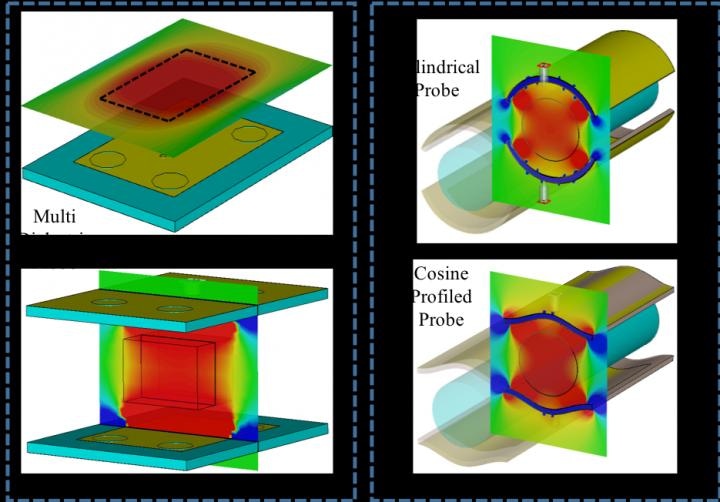Nov 1 2018
High-resolution magnetic resonance imaging (MRI) machines can function better when the structure of radio probes is changed from coils to antennas.
 Proposed radio-frequency probes to create homogeneous magnetic field within a phantom under study: single multi dielectric patch surface probe (upper left), volume probe composed of two vis-à-vis placed dielectric patch probes (lower left), volume probe composed of two cylindrical patches (upper right) and cosine-profiled patches (lower right). (Image credit: Navid P. Gandji)
Proposed radio-frequency probes to create homogeneous magnetic field within a phantom under study: single multi dielectric patch surface probe (upper left), volume probe composed of two vis-à-vis placed dielectric patch probes (lower left), volume probe composed of two cylindrical patches (upper right) and cosine-profiled patches (lower right). (Image credit: Navid P. Gandji)
The way to make a high-frequency MRI machine more precise is by using an electrical engineering method to create a better, uniform magnetic field.
In a new research reported in Transactions on Microwave Theory and Techniques (DOI: 10.1109/TMTT.2018.2874266), scientists learned that radio frequency probes with structures stimulated by microstrip patch antennas boost MRI resolution in high-frequency MRI machines when compared to conventional surface coils used presently.
“When frequencies become higher, wavelengths become shorter, and your magnetic field loses uniformity,” says Elena Semouchkina, an associate professor of electrical and computer engineering at Michigan Technological University. “Uniformity is important for high-resolution images, so we proposed a new approach to developing these probes.”
A Common Design, Tuned with Optics
Semouchkina elucidates that the type of antenna one sees on the top of a building is not quite the same thing used here, but rather, the team’s design was inspired by microstrip patch antenna (MPA). The design is comparatively simple: MPAs are composed of a flat piece of metal grounded by a larger piece of metal. They are simple, cheap, and easy to make, which is why they are frequently used in telecommunications.
MRIs function by issuing radio frequency pulses in a magnetic field via probes with bird-cage-like structures or coils. That’s then used to develop an image.
However, those conventional coils have frequency limits: too high and they cannot form uniformed magnetic fields at the volume the scientists need.
MPAs are a substitute where waves oscillate in the cavity developed between the patch and ground plane electrodes, which are accompanied by currents in the patch electrode and, respectively, oscillating magnetic fields around the patch, providing a magnetic field that is both uniform and strong.
“While the complexity of birdcage coils increases with the increase in operation frequency, patch-based probes can provide quality performance in the higher microwave range while still having a relatively simple structure,” Semouchkina says. They also exhibited smaller radiation losses, making them competitive with, and much better than, traditional coils.
High-Frequency MRI Machines—and Invisibility Cloaks
Due to the harm high-frequency radio waves cause to humans, the research was restricted to high-frequency machines—not the metal tube that one is used to seeing in medical and hospitals centers. Humans can only withstand frequencies up to seven Teslas, but ultrahigh fields up to 21.1 Teslas can be used in tissue samples and in testing on animal models.
Semouchkina is already renowned for her efforts involving invisibility cloaks, which include redirecting electromagnetic waves around an area to conceal an object. “We use some of the same approaches that we developed in cloaking devices here, like making antenna smaller,” she said.
This research was conducted with Navid P. Gandji and George Semouchkin of Michigan Tech, and Gangchea Lee, Thomas Neubereger, and Micheal Lanagan of Pennsylvania State University. Going forward, the team plans to keep applying electrical engineering to alter those probes to make them function better, and to further increase the possibilities for high-frequency MRI machines and the images they form.